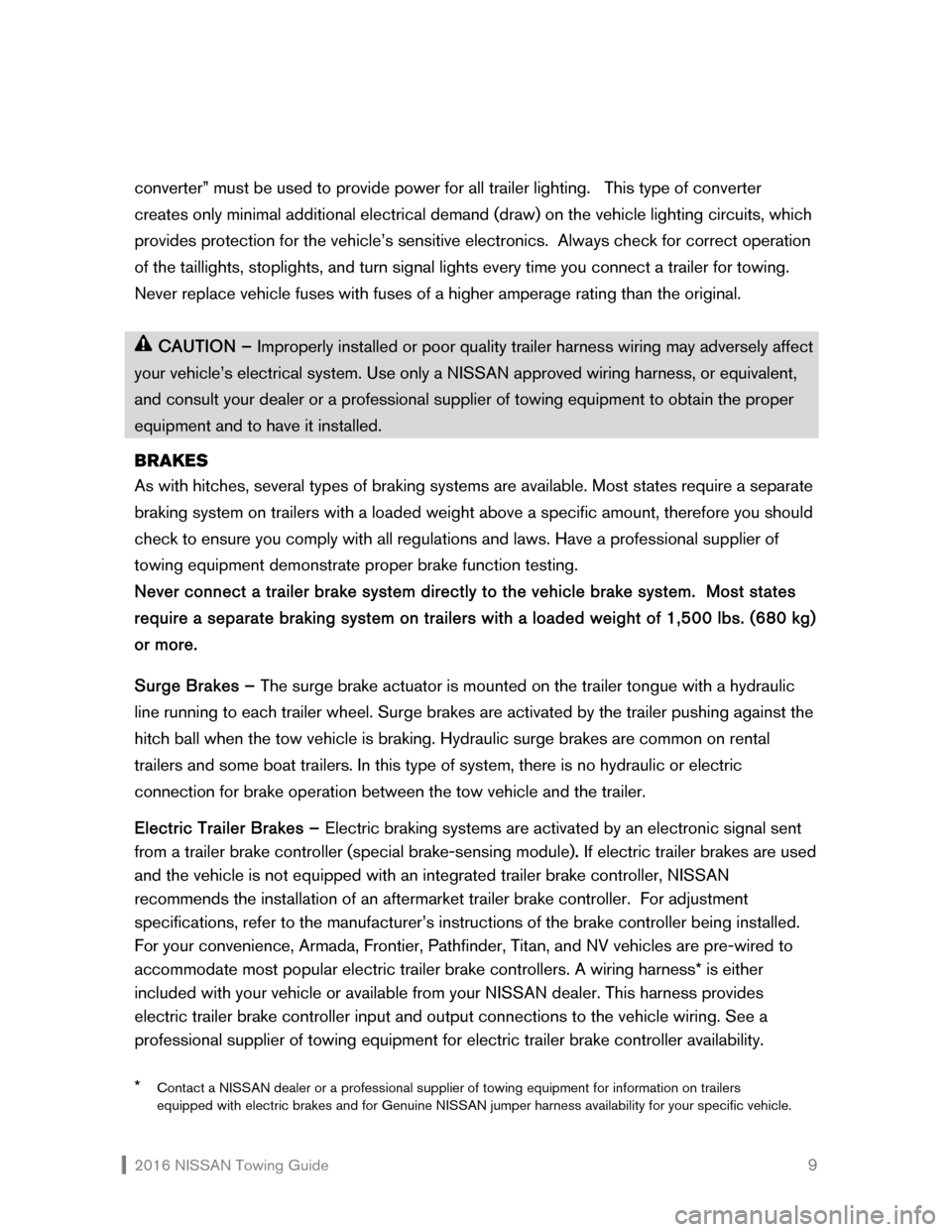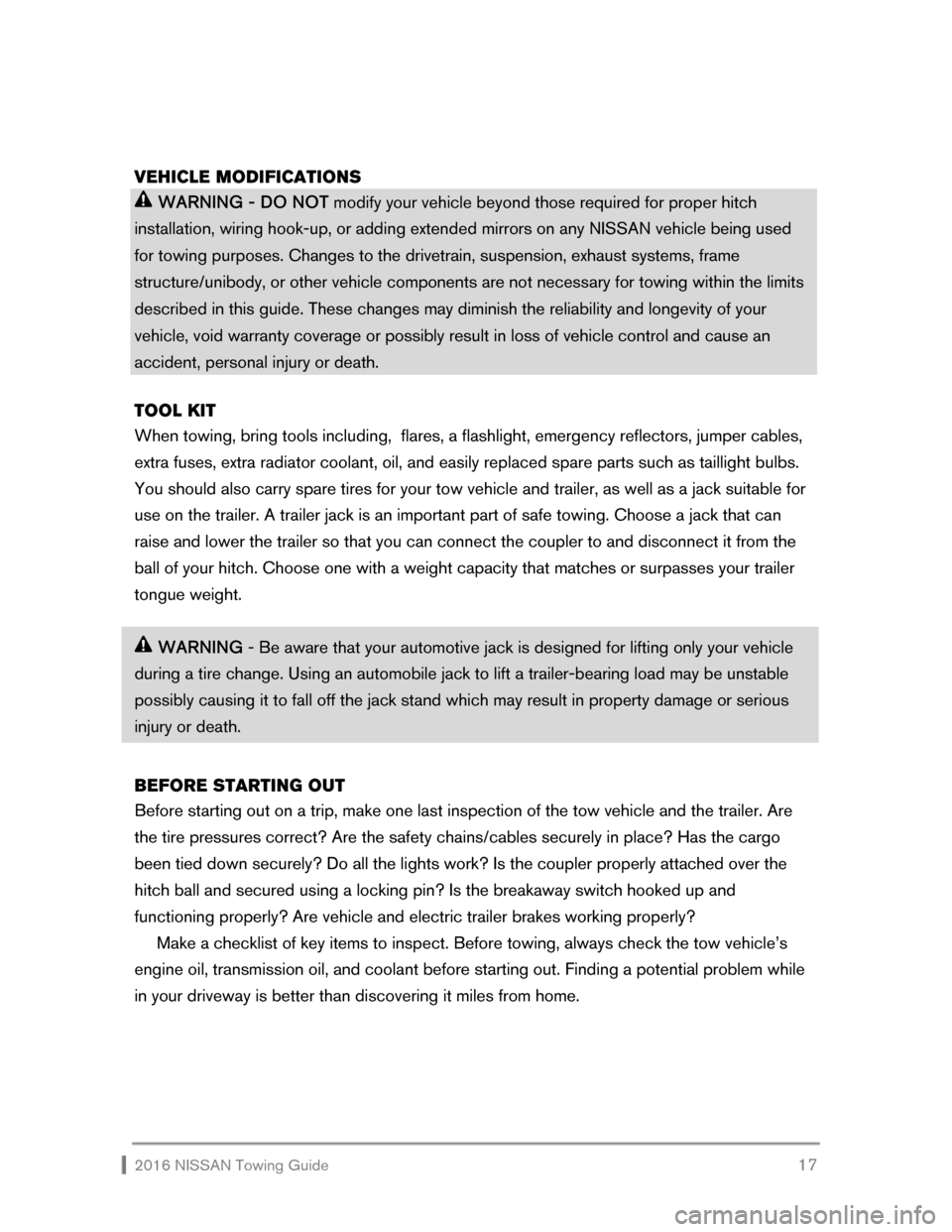fuse NISSAN ROGUE 2016 2.G Towing Guide
[x] Cancel search | Manufacturer: NISSAN, Model Year: 2016, Model line: ROGUE, Model: NISSAN ROGUE 2016 2.GPages: 27, PDF Size: 0.55 MB
Page 10 of 27

2016 NISSAN Towing Guide 9
converter” must be used to provide power for all trailer lighting. This type of converter
creates only minimal additional electrical demand (draw) on the vehicle lighting circuits, which
provides protection for the vehicle’s sensitive electronics. Always check for correct operation
of the taillights, stoplights, and turn signal lights every time you connect a trailer for towing.
Never replace vehicle fuses with fuses of a higher amperage rating than the original.
CAUTION – Improperly installed or poor quality trailer harness wiring may adversely affect
your vehicle’s electrical system. Use only a NISSAN approved wiring harness, or equivalent,
and consult your dealer or a professional supplier of towing equipment to obtain the proper
equipment and to have it installed.
BRAKES
As with hitches, several types of braking systems are available. Most states require a separate
braking system on trailers with a loaded weight above a specific amount, therefore you should
check to ensure you comply with all regulations and laws. Have a professional supplier of
towing equipment demonstrate proper brake function testing.
Never connect a trailer brake system directly to the vehicle brake system. Most states
require a separate braking system on trailers with a loaded weight of 1,500 lbs. (680 kg)
or more.
Surge Brakes – The surge brake actuator is mounted on the trailer tongue with a hydraulic
line running to each trailer wheel. Surge brakes are activated by the trailer pushing against the
hitch ball when the tow vehicle is braking. Hydraulic surge brakes are common on rental
trailers and some boat trailers. In this type of system, there is no hydraulic or electric
connection for brake operation between the tow vehicle and the trailer.
Electric Trailer Brakes – Electric braking systems are activated by an electronic signal sent
from a trailer brake controller (special brake-sensing module). If electric trailer brakes are used
and the vehicle is not equipped with an integrated trailer brake controller, NISSAN
recommends the installation of an aftermarket trailer brake controller. For adjustment
specifications, refer to the manufacturer’s instructions of the brake controller being installed.
For your convenience, Armada, Frontier, Pathfinder, Titan, and NV vehicles are pre-wired to
accommodate most popular electric trailer brake controllers. A wiring harness* is either
included with your vehicle or available from your NISSAN dealer. This harness provides
electric trailer brake controller input and output connections to the vehicle wiring. See a
professional supplier of towing equipment for electric trailer brake controller availability.
*
Contact a NISSAN dealer or a professional supplier of towing equipment for information on trailers
equipped with electric brakes and for Genuine NISSAN jumper harness availability for your specific vehicle.
Page 18 of 27

2016 NISSAN Towing Guide 17
VEHICLE MODIFICATIONS
WARNING - DO NOT modify your vehicle beyond those required for proper hitch
installation, wiring hook-up, or adding extended mirrors on any NISSAN vehicle being used
for towing purposes. Changes to the drivetrain, suspension, exhaust systems, frame
structure/unibody, or other vehicle components are not necessary for towing within the limits
described in this guide. These changes may diminish the reliability and longevity of your
vehicle, void warranty coverage or possibly result in loss of vehicle control and cause an
accident, personal injury or death.
TOOL KIT
When towing, bring tools including, flares, a flashlight, emergency reflectors, jumper cables,
extra fuses, extra radiator coolant, oil, and easily replaced spare parts such as taillight bulbs.
You should also carry spare tires for your tow vehicle and trailer, as well as a jack suitable for
use on the trailer. A trailer jack is an important part of safe towing. Choose a jack that can
raise and lower the trailer so that you can connect the coupler to and disconnect it from the
ball of your hitch. Choose one with a weight capacity that matches or surpasses your trailer
tongue weight.
WARNING - Be aware that your automotive jack is designed for lifting only your vehicle
during a tire change. Using an automobile jack to lift a trailer-bearing load may be unstable
possibly causing it to fall off the jack stand which may result in property damage or serious
injury or death.
BEFORE STARTING OUT
Before starting out on a trip, make one last inspection of the tow vehicle and the trailer. Are
the tire pressures correct? Are the safety chains/cables securely in place? Has the cargo
been tied down securely? Do all the lights work? Is the coupler properly attached over the
hitch ball and secured using a locking pin? Is the breakaway switch hooked up and
functioning properly? Are vehicle and electric trailer brakes working properly?
Make a checklist of key items to inspect. Before towing, always check the tow vehicle’s
engine oil, transmission oil, and coolant before starting out. Finding a potential problem while
in your driveway is better than discovering it miles from home.